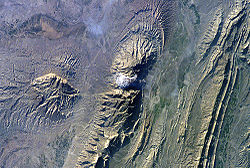- Hajji Firuz Tepe
-
Hajji Firuz Tepe se trata de una asentamiento del Neolítico ubicado en los Montes Zagros (Irán).[1] [2] Es a la vista de muchos historiadores uno de los primeros lugares donde consta se elaboró vino procedente de la uva (vitis vinífera) por primera vez en la historia de la humanidad.[3] Se sabe por la determinación de ácido tartárico en analíticas realizadas en las trazas encontradas en recipientes de alfarería.[4]
Asentamiento
Desde la década de 1960 se llevan realizando diversas excavaciones arqueológicas y descubriendo asentamientos diversos procedentes de la época del neolítico. Estas excavaciones han dado lugar a numerosos utensilios de la época que han sido estudiados y analizados posteriormente. Las excavaciones comenzaron en Irán a finales del siglo XIX.[2] El asentamiento se encuentra al noroeste del valle de Solduz a dos escasos quilómetros de la población de Hajji Firuz.
Véase también
Referencias
- ↑ Voigt, M. M. Hajji Firuz Tepe, Iran: The Neolithic Settlement
- ↑ a b Mary M. Voigt, (1983), Hajji Firuz Tepe, Iran: The Neolithic Settlement (inglés), University of Pennsylvania Museum Publication
- ↑ E. McGovern, Patrick (2003) (en inglés). Ancient Wine: The Search for the Origins of Viniculture (primera edición). Princeton University Press. pp. 400 p.p.. ISBN 0691070806. «intro de Robert G. Mondavi»
- ↑ E. McGovern, Patrick; D.L. Glusker, L.J. Exner, y M.M Voight (Junio 1996). «Neolihtic resinated wine» (en inglés). Nature (381): pp. 480-481.
Wikimedia foundation. 2010.

